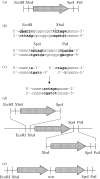Synthetic biology and biomass conversion: a match made in heaven?
- PMID: 19454530
- PMCID: PMC2843956
- DOI: 10.1098/rsif.2008.0527.focus
Synthetic biology and biomass conversion: a match made in heaven?
Abstract
To move our economy onto a sustainable basis, it is essential that we find a replacement for fossil carbon as a source of liquid fuels and chemical industry feedstocks. Lignocellulosic biomass, available in enormous quantities, is the only feasible replacement. Many micro-organisms are capable of rapid and efficient degradation of biomass, employing a battery of specialized enzymes, but do not produce useful products. Attempts to transfer biomass-degrading capability to industrially useful organisms by heterologous expression of one or a few biomass-degrading enzymes have met with limited success. It seems probable that an effective biomass-degradation system requires the synergistic action of a large number of enzymes, the individual and collective actions of which are poorly understood. By offering the ability to combine any number of transgenes in a modular, combinatorial way, synthetic biology offers a new approach to elucidating the synergistic action of combinations of biomass-degrading enzymes in vivo and may ultimately lead to a transferable biomass-degradation system. Also, synthetic biology offers the potential for assembly of novel product-formation pathways, as well as mechanisms for increased solvent tolerance. Thus, synthetic biology may finally lead to cheap and effective processes for conversion of biomass to useful products.
Figures


References
-
- Andersen N., Johansen K. S., Michelsen M., Stenby E. H., Krogh K. B. R. M., Olsson L. 2008. Hydrolysis of cellulose using mono-component enzymes shows synergy during hydrolysis of phosphoric acid swollen cellulose (PASC), but competition on Avicel. Enzyme Microb. Technol. 42, 362–370. (10.1016/j.enzmictec.2007.11.018) - DOI
Publication types
MeSH terms
Substances
LinkOut - more resources
Full Text Sources
Miscellaneous
